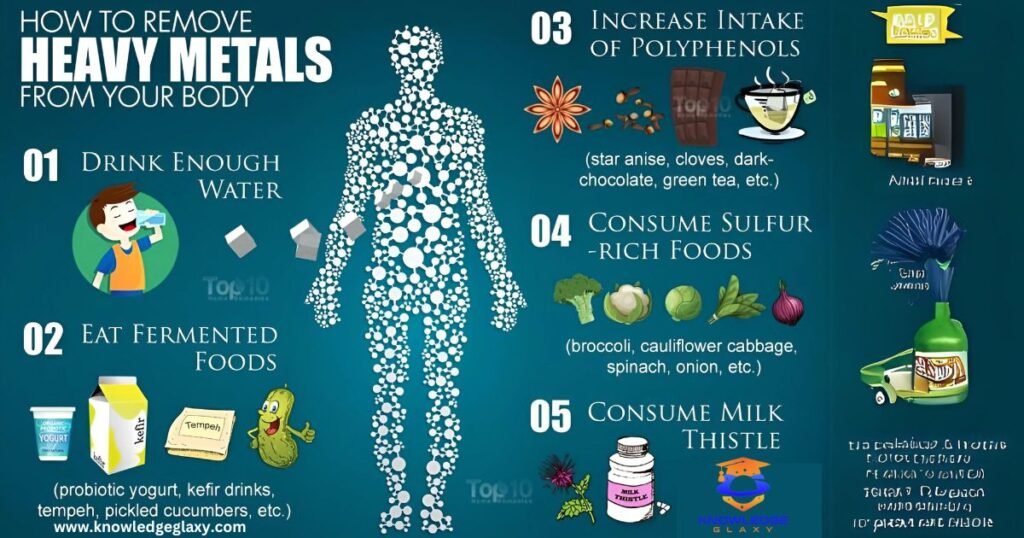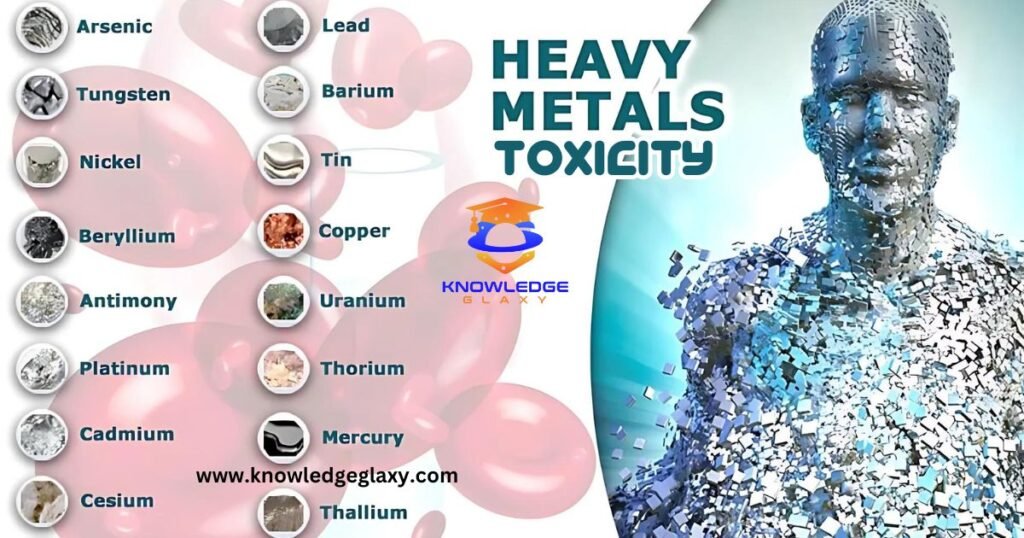Heavy metal toxicity occurs when the body accumulates excessive levels of heavy metals, leading to a variety of health issues. Heavy metals are naturally occurring elements with a high atomic weight and density, and they can be toxic even in small amounts. Common heavy metals that can cause toxicity include lead, mercury, arsenic, and cadmium.
Symptoms of Heavy Metal Toxicity
The symptoms of heavy metal toxicity can vary depending on the type of metal, the level of exposure, and the duration of exposure. Some common symptoms include:
Read More: Plant-Based Diet in 2024

- Neurological Symptoms:
- Headaches
- Memory loss
- Difficulty concentrating
- Numbness and tingling in the extremities
- Tremors
- Seizures
- Gastrointestinal Symptoms:
- Abdominal pain
- Nausea and vomiting
- Diarrhea
- Constipation
- Cardiovascular Symptoms:
- High blood pressure
- Irregular heartbeat
- Chest pain
- Respiratory Symptoms:
- Shortness of breath
- Coughing
- Wheezing
- Skin and Hair Symptoms:
- Rashes
- Hair loss
- Brittle nails
- General Symptoms:
- Fatigue
- Weakness
- Muscle and joint pain
- Anemia
Causes of Heavy Metal Toxicity
Heavy metal can result from various sources, including:
- Environmental Exposure:
- Contaminated air, water, and soil
- Industrial waste and pollution
- Pesticides and fertilizers
- Occupational Exposure:
- Working in industries such as mining, smelting, and manufacturing
- Exposure to heavy metals in the workplace
- Dietary Exposure:
- Consuming contaminated food and water
- Eating fish high in mercury, such as swordfish and shark
- Medical Exposure:
- Dental amalgams containing mercury
- Certain medications and vaccines
- Consumer Products:
- Lead-based paints and toys
- Cosmetics and personal care products containing heavy metals
Diagnosis of Heavy Metal Toxicity
Diagnosing heavy metal toxicity typically involves a combination of medical history, physical examination, and laboratory tests. Common diagnostic methods include:
- Blood Tests:
- Measuring the levels of heavy metals in the blood
- Urine Tests:
- Analyzing urine samples for the presence of heavy metals
- Hair Analysis:
- Testing hair samples for heavy metal content
- Imaging Studies:
- X-rays or CT scans to detect heavy metal deposits in the body
Treatment of Heavy Metal Toxicity
The treatment of heavy metal toxicity depends on the type and severity of the exposure. Common treatment options include:
- Chelating Agents:
- Medications that bind to heavy metals and help the body excrete them
- Examples include EDTA, DMSA, and DMPS
- Dietary Changes:
- Avoiding foods high in heavy metals
- Consuming a diet rich in antioxidants and nutrients that support detoxification
- Lifestyle Modifications:
- Avoiding exposure to heavy metals in the environment and workplace
- Using protective gear when working with heavy metals
- Supportive Care:
- Managing symptoms such as pain, nausea, and fatigue
- Monitoring organ function and providing supportive therapies as needed
Prevention of Heavy Metal Toxicity
Preventing heavy metal toxicity involves reducing exposure to heavy metals through various measures:

- Environmental Awareness:
- Avoiding contaminated areas and products
- Supporting environmental regulations and clean-up efforts
- Occupational Safety:
- Using protective gear and following safety protocols in the workplace
- Regular monitoring of heavy metal levels in workers
- Dietary Choices:
- Consuming a balanced diet with minimal exposure to heavy metals
- Avoiding fish high in mercury and other contaminated foods
- Medical Precautions:
- Being cautious with medications and vaccines that may contain heavy metals
- Consulting with healthcare providers about potential risks
- Consumer Awareness:
- Choosing products that are free from heavy metals
- Avoiding lead-based paints and toys
Heavy Metal Toxicity: Neurological Symptoms
Heavy metal can have severe neurological effects, impacting the brain and nervous system. Symptoms may include cognitive decline, memory loss, tremors, and seizures. These symptoms can vary in severity and may develop gradually over time, making early detection crucial.
Heavy Metal Toxicity in Toddlers
Toddlers are particularly vulnerable to heavy metal toxicity due to their developing bodies and immature immune systems. Exposure to heavy metals can lead to developmental delays, behavioral issues, and impaired cognitive function. It is essential to monitor their environment and diet to minimize exposure.
Symptoms of Heavy Metal Toxicity
The symptoms of heavy metal toxicity can vary widely depending on the type of metal and the level of exposure. Common symptoms include fatigue, headaches, abdominal pain, and skin irritation. In severe cases, organ damage and neurological issues may occur.
Effects of Heavy Metals in the Body
Heavy metals can accumulate in various organs and tissues, leading to a range of health issues. They can damage the liver, kidneys, lungs, and brain, and may also affect the reproductive and immune systems. Prolonged exposure can result in chronic health problems and even life-threatening conditions.
Symptoms of Heavy Metal Toxicity in Adults
Adults may experience a variety of symptoms due to heavy metal toxicity, including muscle weakness, joint pain, gastrointestinal problems, and respiratory issues. Chronic exposure can lead to more severe health problems, such as cardiovascular disease and cancer.
What Are Three Symptoms of Heavy Metal Poisoning?
Three common symptoms of heavy metal poisoning are fatigue, headaches, and abdominal pain. These symptoms can be indicative of exposure to heavy metals such as lead, mercury, or cadmium, and should be taken seriously.
Symptoms of Heavy Metal in Toddlers
In toddlers, heavy metal can manifest as developmental delays, behavioral changes, and cognitive impairment. Other symptoms may include irritability, poor appetite, and gastrointestinal issues. Early intervention is crucial to prevent long-term health problems.
Heavy Metal Toxicity Treatment
Treatment for heavy metal toxicity typically involves chelation therapy, which uses chelating agents to bind to and remove heavy metals from the body. Other treatments may include dietary changes, supplements, and supportive therapies to manage symptoms and promote recovery.
Conclusion:
Heavy metal toxicity is a serious health concern that can lead to a wide range of symptoms and complications. Early diagnosis and treatment are crucial to prevent long-term damage. If you suspect you may have been exposed to heavy metals, it’s important to consult your doctor for a proper diagnosis and appropriate treatment. Taking preventive measures can help reduce the risk of heavy metal and protect your health.
FAQs:
Q: What are the most common Heavy Metal Toxicity that cause toxicity?
A: The most common heavy metals that cause toxicity include lead, mercury, arsenic, and cadmium.
Q: How is heavy metal toxicity diagnosed?
A: Heavy metal toxicity is typically diagnosed through a combination of medical history, physical examination, and laboratory tests, including blood tests, urine tests, hair analysis, and imaging studies.
Q: What are the treatment options for heavy metal toxicity?
A: Treatment options for heavy metal toxicity include chelating agents, dietary changes, lifestyle modifications, and supportive care. Chelating agents are medications that bind to heavy metals and help the body excrete them.
Q: How can heavy metal be prevented?
A: Preventing heavy metal involves reducing exposure to heavy metals through environmental awareness, occupational safety, dietary choices, medical precautions, and consumer awareness.
Q: What are the symptoms of heavy metal toxicity?

A: Symptoms of heavy metal toxicity can vary but may include neurological symptoms (headaches, memory loss, numbness), gastrointestinal symptoms (abdominal pain, nausea), cardiovascular symptoms (high blood pressure, irregular heartbeat), respiratory symptoms (shortness of breath, coughing), skin and hair symptoms (rashes, hair loss), and general symptoms (fatigue, weakness, muscle pain).
For more information, visit Knowledge Galaxy to learn about the symptoms, diagnosis, causes, and treatment of heavy metal toxicity.






